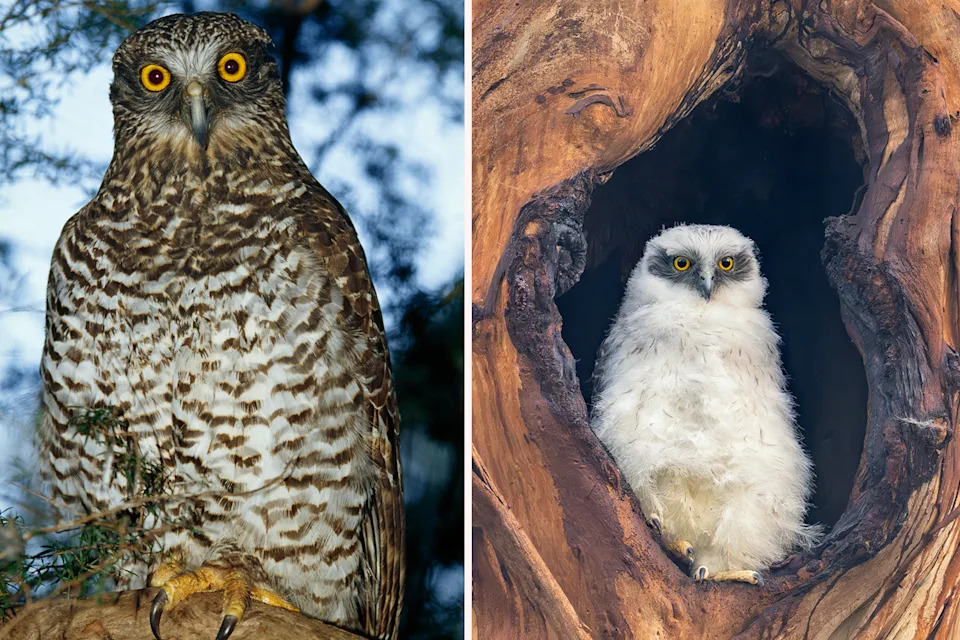Walking up a hill blanketed in thick bushland on Thursday, a Victorian grandmother could feel something watching her. “There was no noise or anything, it was just that sixth sense thing,” she told Yahoo News.
Scanning the forest, she was excited to discover a 50cm-high predatory owl staring back at her from a low-hanging branch.
She immediately focused her camera on the bird, without yet comprehending the rarity of what she was photographing.
“It was just staring back at me, probably thinking, ‘What the hell are you looking at’?” she said.
“What went through my mind was, ‘Get a photo really quickly before it takes off’.”
What she had witnessed was a powerful owl, a species vulnerable to extinction in Victoria, eating what appears to be the corpse of a greater glider, which is listed as nationally endangered.
The woman, who has lived on the property for decades, had no idea either species lived in the forest, although she had sometimes heard owls calling.

When the photographer returned, only parts of the corpse remained. Source: Supplied
“I’d never seen anything like it before… It had eaten its head off,” she said.
Because of the moment’s rarity, she has asked not to be named, and the exact location of her property is not disclosed.
However, Yahoo News is permitted to reveal it occurred in Gladysdale in the Yarra Valley, around 70km east of Melbourne.
Why expert is conflicted by owl and glider image
When Birdlife Australia’s powerful owl expert Dr Holly Parsons, saw the images for the first time on Monday, she was amazed, but also conflicted.
“It’s really exciting when you see a powerful owl, but when its prey is a threatened species as well it can be really hard to look at,” she said.
“But that’s what you want to see, that natural predator and prey relationship, so it’s potentially a good thing, you could say.”
Related: Tense moment ‘survivors’ of ancient Aussie species released

Greater gliders create their dens inside tree hollows. Source: The Greater Glider Project
Greater gliders can weigh up to 1.7kg and grow up to 1 metre in length, including their tail, meaning they’re at the upper limit of powerful owl prey.
It’s more common to see them eating other tree-dwelling species, including ringtail and brushtail possums, birds, flying foxes, or even koala joeys.
The main reason it’s rare to see one eating a greater glider is simply that there aren’t many left, primarily due to bushfires, but also state governments and developers bulldozing their homes.
“There should be enough greater gliders out there to be prey for powerful owls, both for their own right, but also as a food item that helps support the whole ecosystem,” Dr Parsons said.
Key reason both species are so rare
Victoria was once home to the world’s oldest tree, but this 114.3 metre-high mountain ash, known as the Cornthwaite Tree, was felled in 1884.
Today, very little of the forest that towered above the state prior to European settlement remains – for instance, less than 2 per cent of the state’s old-growth mountain ash forest is left.

Powerful owls need large hollows to raise their chicks. Source: Getty
Both greater gliders and powerful owls raise their young inside tree hollows which are now increasingly rare, and only start to form inside trunks that are a century old.
“Powerful owls need very large trees with a nice, deep hollow, and once those are gone from the landscape, you’re removing an entire territory, because there’s no way for birds to breed,” Parsons said.
“There is also increasing fire that takes out trees, and you have issues of rodenticides, and car strikes, and all the other human-induced risks we throw their way.”
Love Australia’s weird and wonderful environment? 🐊🦘😳 Get our new newsletter showcasing the week’s best stories.

